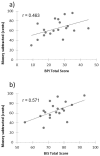Experimentally Assessed Reactive Aggression in Borderline Personality Disorder
- PMID: 27851804
- PMCID: PMC5112922
- DOI: 10.1371/journal.pone.0166737
Experimentally Assessed Reactive Aggression in Borderline Personality Disorder
Abstract
Approximately 73% of patients suffering from Borderline personality disorder (BPD) exhibit aggressive behaviour, which severely hinders therapeutic work and clinical improvement. Because the underlying mechanisms of aggression in BPD are not yet completely understood, additional research in this domain has a high clinical and scientific relevance. We employed a modified version of the Taylor Aggression Paradigm (mTAP), in order to examine for the first time whether this task can be used to differentiate between BPD patients and healthy controls with regard to reactive aggression. In the mTAP, the amount of money subtracted by a virtual opponent was categorized into 'low' (10-20 cents) and 'high' (80-100 cents) provocations, enabling us to compare how much money BPD patients and healthy controls subtracted (i.e., how aggressively participants responded) following high and low provocation trials. Our results showed that, compared to healthy controls, BPD patients showed higher overall aggression, higher aggression after high provocation trials, as well as a larger difference between high and low provocation trials. This finding was corroborated by a neuropsychological assessment, demonstrating higher levels of aggression and impulsivity in BPD patients. Interestingly, reactive aggression in the mTAP was positively correlated with symptom severity and impulsivity in BPD patients. We suggest that the mTAP provides a valuable tool allowing psychiatrists to quantify reactive aggression in BPD. Therefore, clinicians and researchers might consider this task, as a short experimental measure of reactive aggression, either in future studies or to aid diagnostic assessment during clinical practice.
Conflict of interest statement
The authors have declared that no competing interests exist.
Figures



Similar articles
-
Laboratory induced aggression: a positron emission tomography study of aggressive individuals with borderline personality disorder.Biol Psychiatry. 2009 Dec 15;66(12):1107-14. doi: 10.1016/j.biopsych.2009.07.015. Epub 2009 Sep 12. Biol Psychiatry. 2009. PMID: 19748078 Free PMC article.
-
Gender differences and similarities in aggression, suicidal behaviour, and psychiatric comorbidity in borderline personality disorder.Acta Psychiatr Scand. 2019 Feb;139(2):145-153. doi: 10.1111/acps.12981. Epub 2018 Nov 12. Acta Psychiatr Scand. 2019. PMID: 30353921
-
Impulsivity and aggression mediate regional brain responses in Borderline Personality Disorder: An fMRI study.Psychiatry Res Neuroimaging. 2017 Feb 28;260:76-85. doi: 10.1016/j.pscychresns.2016.12.009. Epub 2016 Dec 16. Psychiatry Res Neuroimaging. 2017. PMID: 28039797 Free PMC article.
-
Aggression in borderline personality disorder.Psychiatr Q. 2010 Sep;81(3):239-51. doi: 10.1007/s11126-010-9133-3. Psychiatr Q. 2010. PMID: 20390357 Review.
-
[Borderline personality disorder, self-mutilation and suicide: literature review].Encephale. 2008 Oct;34(5):452-8. doi: 10.1016/j.encep.2007.10.007. Epub 2008 Feb 20. Encephale. 2008. PMID: 19068333 Review. French.
Cited by
-
Dissociation of behavioral and neural responses to provocation during reactive aggression in healthy adults with high versus low externalization.Cogn Affect Behav Neurosci. 2022 Oct;22(5):1130-1144. doi: 10.3758/s13415-021-00981-y. Epub 2022 Jan 28. Cogn Affect Behav Neurosci. 2022. PMID: 35091989 Free PMC article.
-
Investigating proactive aggression in patients with borderline personality disorder and major depressive disorder using a modified version of the Taylor aggression paradigm.Front Psychol. 2024 Dec 13;15:1439924. doi: 10.3389/fpsyg.2024.1439924. eCollection 2024. Front Psychol. 2024. PMID: 39734773 Free PMC article.
-
Borderline Personality Disorder and Violence Toward Self and Others: A National Study.J Pers Disord. 2019 Oct;33(5):653-670. doi: 10.1521/pedi_2018_32_361. Epub 2018 Oct 11. J Pers Disord. 2019. PMID: 30307827 Free PMC article.
References
-
- Veroude K, Zhang-James Y, Fernàndez-Castillo N, Bakker MJ, Cormand B, Faraone SV. Genetics of aggressive behavior: An overview. Am J Med Genet Part B. 2015; 9999: 1–41. - PubMed
MeSH terms
LinkOut - more resources
Full Text Sources
Other Literature Sources

